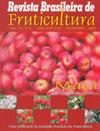百香果炭疽病的生物防治
IF 0.9
4区 农林科学
Q4 HORTICULTURE
引用次数: 0
摘要
摘要:研究了生物制品作为病害防治的替代品,减少了对环境、人体和动物的影响,在采后取得了令人满意的效果。本研究旨在评价生物制剂对黄百香果炭疽病菌的防治效果和采后品质的影响。处理浓度为0,5的曲霉木霉和酿酒酵母菌;1, 0;1、5;2,0 (g. L-1);代森锰锌杀菌剂(Dithane®2 g i.a L-1水)和对照(无菌蒸馏水)。每个处理浸泡2 min后进行干旱处理。采用3个果实的5个重复对黄百香果进行了炭疽病严重程度分析和理化品质分析。将炭疽病菌沉积在先前用火焰穿孔器打孔处理过的果实表面进行接种。在研究中评价了:pH、总可溶性固形物和可滴定酸度。生物处理降低了黄色百香果的炭疽病严重程度。生物防治对果实采后品质无显著影响。在本研究条件下,对百香果进行采后炭疽病管理是一种可行的替代方法。本文章由计算机程序翻译,如有差异,请以英文原文为准。
Biological control of anthracnose in passion fruit
Abstract The biological products use as a disease control alternative has been studied to reduce the impacts to the environment, men and animals, showing satisfactory results in postharvest. This study aimed to evaluate the biological agents effect in the control of Colletotrichum spp. and on postharvest quality of yellow passion fruit. The treatments were Trichoderma asperellum and Saccharomyces cerevisiae species at concentrations of of 0,5; 1,0; 1,5; 2,0 (g. L-1); Mancozeb fungicide (Dithane® 2 g i.a. L-1 water) and control (sterile distilled water). The fruits were immersed for 2 min in each treatment and then were drought. Five replications of three fruits were used to anthracnose severity analysis and yellow passion fruit physical-chemical quality in. The fruit inoculation was made with the deposition of Colletotrichum spp. on the surface of the fruit previously treated using holes which were made with the aid of a flamed perforator. In the research was evaluated: pH, total soluble solids and titratable acidity. Biological treatments reduced the anthracnose severity in yellow passion fruit. Fruit Post-harvest quality was not influenced by the biological control application. It is a viable alternative to postharvest management of anthracnose on yellow passion fruit under the studied conditions.
求助全文
通过发布文献求助,成功后即可免费获取论文全文。
去求助
来源期刊
CiteScore
1.50
自引率
20.00%
发文量
34
审稿时长
4-8 weeks
期刊介绍:
The Revista Brasileira de Fruticultura (RBF) publishes technical articles and scientific communications in the area of fruit crops, referring to results of original searches and unpublished papers in Portuguese, Spanish or English, and 1 or 2 reviews per edition, of invited authors.

 求助内容:
求助内容: 应助结果提醒方式:
应助结果提醒方式:


